By Christopher Booker
There has been a curious by-product of the attempts being made by the University of East Anglia to whitewash last November’s embarrassing leak of documents from its Climatic Research Unit. Since it set up not one but two supposedly “independent” inquiries into the “Climategate” affair, climate sceptics were intrigued but not entirely surprised to find that almost all their members were committed, even fanatical advocates of global warming, and hence unlikely to be over-critical of the CRU’s bizarre record.
Most recently, the sceptics have been particularly intrigued by the background of the man chosen by the university to chair an assessment of the CRU’s scientific record. Lord Oxburgh declared on his appointment that he is linked to major wind-farm and renewable-energy companies. He admitted that he advises Climate Change Capital, which manages funds worth $1.5 billion, hoping to cash in on the “opportunities created by the transition to a low-carbon economy”, in a world market potentially worth - its website boasts - $45 trilllion.
What Lord Oxburgh kept quiet about, however, is that he is also a director and vice-chairman of a strange little private company few of us had heard of known as Globe International. The name stands for “Global Legislators Organisation for a Balanced Environment”, and it describes itself as a worldwide network to lobby governments to take more drastic action on climate change. Globe is certainly well-connected, as it showed just before last December’s Copenhagen conference by staging a seminar addressed by, among others, the conference’s chairman Yvo de Boer, as well as Nancy Pelosi and Ed Markey, the leaders of the campaign to push a cap-and trade-scheme - which could make a lot of people fabulously rich - through the US Congress.
The international president of this lobbying organisation turns out to be none other than Stephen Byers MP, now best known for his description of himself on last week’s Dispatches as “like a cab for hire”, happy to take 5,000 pounds a day for using his influence as a lobbyist.
Globe clearly knows how to pick its men. Its UK parliamentary team also includes Elliot Morley MP, Globe’s former president, and David Chaytor MP, both of whom now face criminal charges for fraud in connection with their expenses claims, Considering the record of some of his colleagues, it is perhaps not surprising that Lord Oxburgh was not too keen to declare his interest in this odd little outfit when he was appointed to chair an inquiry as to whether the world can rely on the evidence produced by the CRU to support its advocacy for global warming. But I am sure we can all have every confidence as to which way his inquiry’s conclusions are likely to point.
Read more and see comments here.
--------------------
Comments from Dr. Will Alexander on Climategate
“For more than the past 20 years I have searched in vain for scientifically believable evidence of large-scale environmental damage and threats to the African subcontinent’s water supplies that could be attributed to undesirable emissions from our coal-fired power stations and other sources. There could only be one conclusion. The alarmist claims have no foundation in science.
I have often wondered how it will all end. These scientists flouted all the basic procedures for numerical modelling of complex processes. They obviously had no experience in time series analyses. Nor were they familiar with the well documented multi-year anomalies in the hydrometeorological data. They rejected the periodicity in the data that has been known since biblical times and its synchronous linkage with variations in solar activity first reported more than a hundred years ago. Computer model calibration and verification procedures are obviously beyond their knowledge horizon.
Even more importantly, they followed the now discredited Climategate policy of refusing to share their information and procedures with those who disagreed with them. They went even further by distributing vitriolic articles on these scientists. They even demanded that a UK scientific journal should not publish our papers that disagreed with their views.
Now they are about to experience the consequences. They can no longer rely on the authorities to support their extremist views. Fellow scientists particularly those in the applied sciences, are increasingly distancing themselves from the patently alarmist tactics.
A committee of the UK Parliament has already heard evidence regarding the University of East Anglia’s role in the Climategate affair. The United Nations Secretary General has established a committee to report to him on the future activities of the IPCC. The UNFCCC and the IPCC cannot possibly survive in their present form. It now seems increasingly remote that a meaningful international accord will be reached in the foreseeable future whereby all nations agree to reduce their emissions to the required level. The whole climate change issue faces complete disintegration.”
Comments by Nils-Axel Morner
In 1970, the Bay of Bengal was struck by the very powerful Bhola Cyclone. This was a truly disastrous event with a casualty in the order of 500,000 people. This event also caused severe coastal damage. Vast sediment quantities were set in suspension and turbidite flows. At the boarder between India and Bangladesh, these sediment transported down the river accumulated in a mud and sand bar that grew into an island. This newly created island came to be called South Talpatti or New Moore Island.
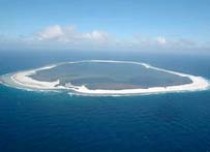
There is nothing strange is this islands come and go by local reasons triggered by sudden events and longer-term dynamic forces. On the 25th of March, it was suddenly announced that the island had disappeared.Many persons, including scientists (for example Sugata Hazra, professor in oceanography at Jadavpur University in Calcutta), took it as an expression of a rapidly rising sea level.
The fact, however, is that it has nothing to do with any global sea level rise, rather local dynamic factors operating in this part of the Bay of Bengal. So, the Island of South Talpatti (New Moor Island) was born in 1970 and killed in 2010; a short life -time of only 40 years. The ultimate cause of its birth was the cyclone damage. The cause of it death is likely to be local dynamic causes operating in this part of the huge delta, and it surely not an effect of a rapid global sea level rise.
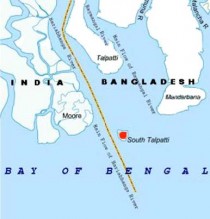
Over the last 40 years we record a virtually fully stable eustatic sea level, even in the Sundarban delta of Bangladesh. The disappearance of the island is by no means a sign of the opposite. See PDF.
See story implying it was rising sea levels here.
Guest post by Willis Eschenbach on Watts Up With That
Inspired by this thread on the lack of data in the Arctic Ocean, I looked into how GISS creates data when there is no data.
GISS is the Goddard Institute for Space Studies, a part of NASA. The Director of GISS is Dr. James Hansen. Dr. Hansen is an impartial scientist who thinks people who don’t believe in his apocalyptic visions of the future should be put on trial for “high crimes against humanity”. GISS produces a surface temperature record called GISTEMP. Here is their record of the temperature anomaly for Dec-Jan-Feb 2010 :
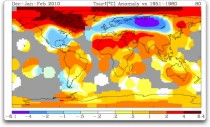
Figure 1. GISS temperature anomalies DJF 2010. Grey areas are where there is no temperature data (enlarged here).
Now, what’s wrong with this picture?
The oddity about the picture is that we are given temperature data where none exists. We have very little temperature data for the Arctic Ocean, for example. Yet the GISS map shows radical heating in the Arctic Ocean. How do they do that?
The procedure is one that is laid out in a 1987 paper by Hansen and Lebedeff In that paper, they note that annual temperature changes are well correlated over a large distance, out to 1200 kilometres (~750 miles).
("Correlation" is a mathematical measure of the similarity of two datasets. It’s value ranges from zero, meaning not similar at all, to plus or minus one, indicating totally similar. A negative value means they are similar, but when one goes up the other goes down.)
Based on Hansen and Lebedeff’s finding of a good correlation (+0.5 or greater) out to 1200 km from a given temperature station, GISS show us the presumed temperature trends within 1200 km of the coastline stations and 1200 km of the island stations. Areas outside of this are shown in gray. This 1200 km. radius allows them to show the “temperature trend” of the entire Arctic Ocean, as shown in Figure 1. This gets around the problem of the very poor coverage in the Arctic Ocean. Here is a small part of the problem, the coverage of the section of the Arctic Ocean north of 80° North:
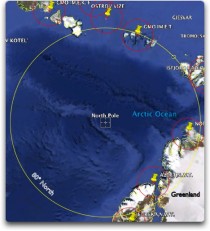
Figure 2. Temperature stations around 80° north. Circles around the stations are 250 km (~ 150 miles) in diameter. Note that the circle at 80°N is about 1200 km in radius, the size out to which Hansen says we can extrapolate temperature trends (enlarged here).
Can we really assume that a single station could be representative of such a large area? Look at Fig.1, despite the lack of data, trends are given for all of the Arctic Ocean. Here is a bigger view, showing the entire Arctic Ocean.
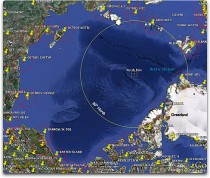
Figure 3. Temperature stations around the Arctic Ocean. Circles around the stations are 250 km (~ 150 miles) in diameter. Note that the area of the Arctic Ocean is about three times the area of the state of Alaska (enlarged here).
What Drs. Hansen and Lebedeff didn’t notice in 1987, and no one seems to have noticed since then, is that there is a big problem with their finding about the correlation of widely separated stations. This is shown by the following graph:
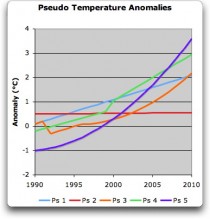
Figure 4. Five pseudo temperature records. Note the differences in the shapes of the records, and the differences in the trends of the records (enlarged here).
Curiously, these pseudo temperature records, despite their obvious differences, are all very similar in one way - correlation. The correlation between each pseudo temperature record and every other pseudo temperature records is above 90%.
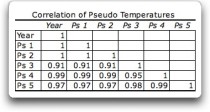
Figure 5. Correlation between the pseudo temperature datasets shown in Fig. 3 (enlarged here).
The inescapable conclusion from this is that high correlations between datasets do not mean that their trends are similar.
OK, I can hear you thinking, “Yea, right, for some imaginary short 20 year pseudo temperature datasets you can find some wild data that will have different trends. But what about real 50-year long temperature datasets like Hansen and Lebedeff used?”
Glad you asked...here are nineteen fifty-year long temperature datasets from Alaska. All of them have a correlation with Anchorage greater than 0.5 (max 0.94, min 0.51, avg .075). These are their trends.
As you can see, the trends range from about one degree in fifty years to nearly three degrees in fifty years. Despite this huge ~ 300% range in trends, all of them have a good correlation (greater than +0.5) with Anchorage. This clearly shows that good correlation between temperature datasets means nothing about their corresponding trends.
Finally, as far as I know, this extrapolation procedure is unique to James Hansen and GISTEMP. It is not used by the other creators of global or regional datasets, such as CRU, NCDC, or USHCN. As Kevin Trenberth stated in the CRU emails regarding the discrepancy between GISTEMP and the other datasets:
My understanding is that the biggest source of this discrepancy [between global temperature datasets] is the way the Arctic is analyzed. We know that the sea ice was at record low values, 22% lower than the previous low in 2005. Some sea temperatures and air temperatures were as much as 7C above normal. But most places there is no conventional data. In NASA [GISTEMP] they extrapolate and build in the high temperatures in the Arctic. In the other records they do not. They use only the data available and the rest is missing.
No data available? No problem, just build in some high temperatures.
Conclusion?
Hansen and Lebedeff were correct that the annual temperature datasets of widely separated temperature stations tend to be well correlated. However, they were incorrect in thinking that this applies to the trends of the well correlated temperature datasets. Their trends may not be similar at all. As a result, extrapolating trends out to 1200 km from a given temperature station is an invalid procedure which does not have any mathematical foundation.
[Update 1] Fred N. pointed out below that GISS shows a polar view of the same data. Note the claimed coverage of the entirety of the Arctic Ocean. Thanks.
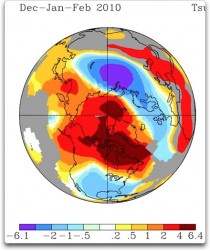
(Enlarged here).
Read full post and comments here.


